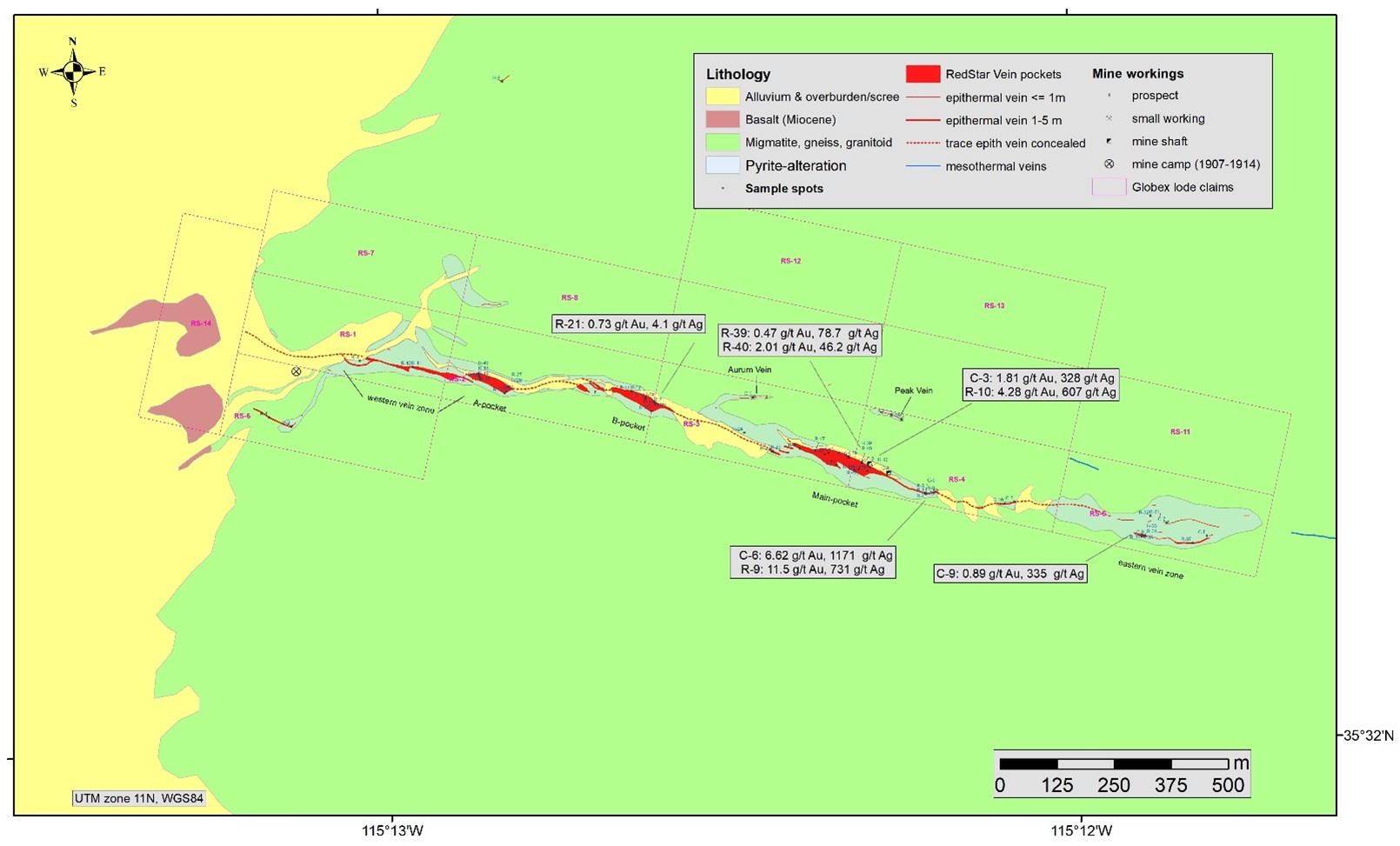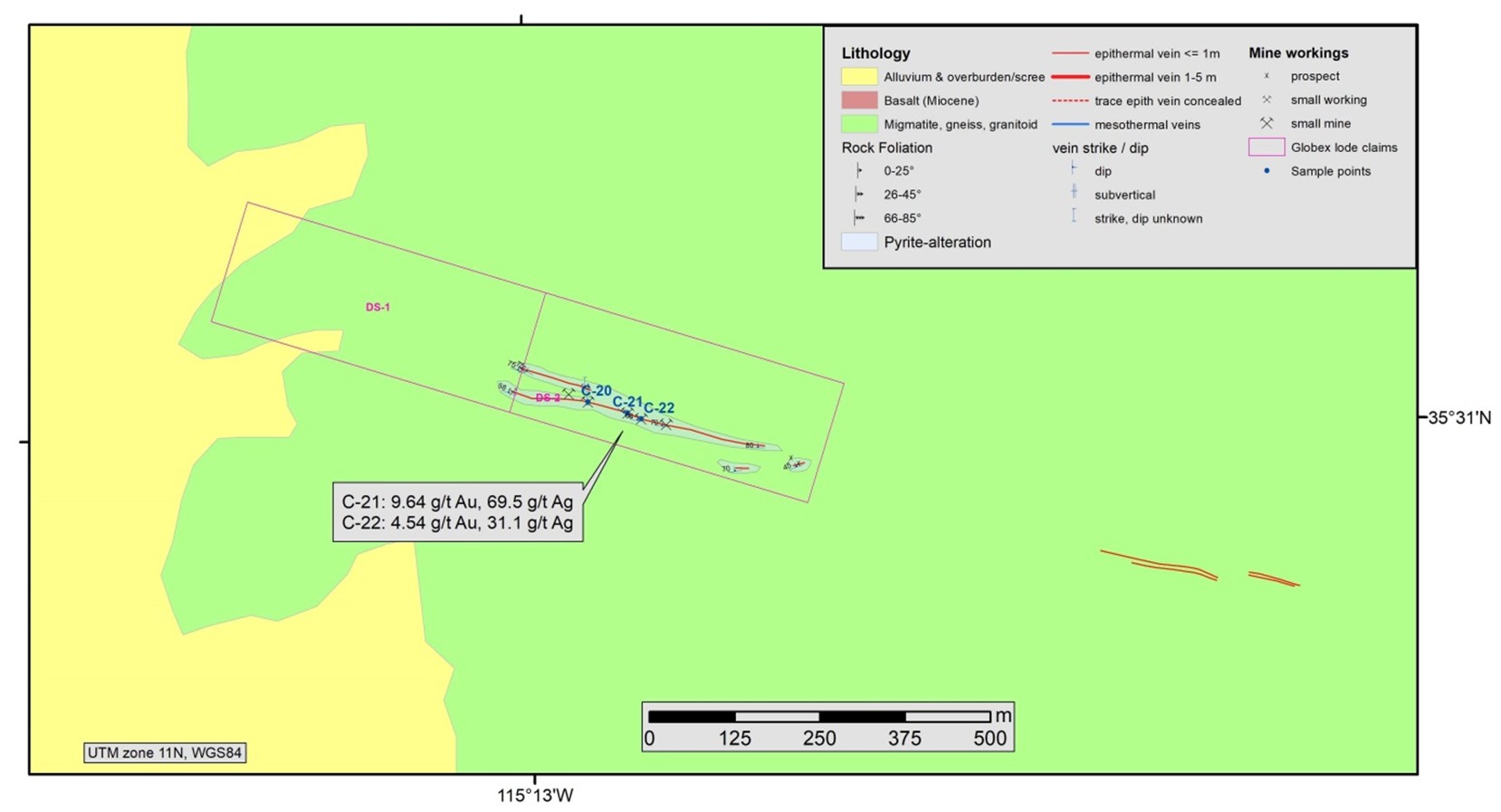Globex’s Gold/Silver Exploration Property in Nevada
globenewswire.com
September 26, 2025 09:00 ET | Source: Globex Mining Enterprises Inc.
ROUYN-NORANDA, Quebec, Sept. 26, 2025 (GLOBE NEWSWIRE) -- GLOBEX MINING ENTERPRISES INC. (GMX – Toronto Stock Exchange, G1MN – Frankfurt, Stuttgart, Berlin, Munich, Tradegate, Lang & Schwarz, LS Exchange, TTMzero, Düsseldorf and Quotrix Düsseldorf Stock Exchanges and GLBXF – OTCQX International in the US) is pleased to make shareholders aware of our 100% owned, 16 unpatented lode claims totaling 133.78 hectares (330.57 acres) staked in Clark County, Nevada, USA. Grab samples collected by Globex assayed up to 1,171 g/t Silver and 11.5 g/t Gold.
History, Geology, Sampling by Globex
The property herein called the Red Star Project was staked to cover two epithermal quartz vein systems, the over 2 km long Red Star vein system and the western, 470m long segment, of the Double Standard vein system. The Double Standard vein zone is located 2.5 km south of the Red Star vein system. The project area is situated at the north-western edge of the historic Crescent Mining district at the western slope of the McCullough Mountain range.
Prospecting began in this district in about 1894, but no important discoveries were made. The period of greatest activity was from 1905 to 1907, when at least 10 incorporated companies were working in this area. Late in 1936 metal mining was revived, stimulated by the increased price of precious metals. Most of this work was carried out by small companies or lessees until 1942. Most of the historic production included turquoise (around the porphyry copper occurrence at Crescent Peak), gold, silver, copper and lead. However, no complete production data is available for the Crescent Mining district. In the early 1980’s Crescent Mining Ltd. exploited the Rest Mine and extracted gold via a heap leach operation. However, no grade or production data are available. Initial historic mining and exploration at the Red Star vein system dates to the period 1907-1914. At that time, it was staked by 5 unpatented lode claims (Red Star Group) owned and operated by the Red Star Mines Company (probably active from 1906 to 1910). In addition, this company also had purchased the high-grade Ag-Au vein system at the Double Standard mine (3 patented claims), located 2.5 km south of the Red Star Group. (Historical data from US government files).
Globex has already carried out initial field work including geological mapping and has collected a total of 65 rock samples (mostly grab samples and linear chip samples) from the Red Star property and two samples from outside the property. These include 60 samples from the Red Star vein, 3 samples from the Double Standard veins, 1 sample from the Peak vein and 1 sample from the Aurum vein (the two latter form part of the Red Star vein system).
The Red Star vein system trends about 100° and the principal Red Star vein dips in average about 55°N. Vein outcroppings of the Red Star system can be followed over a lateral distance of 2000 m, but it is likely that it continues under post-mineral sedimentary and volcanic rock cover at least until the western limit of the Globex claim block (resulting in about a 2240m strike length). Horizontal vein widths of individual or composite quartz veins (including quartz breccias and stockwork zones with > 30% quartz) vary greatly from less than 1 m to 23 m (4 m to 23 m width in the 220 m long Main-pocket). The average vein width is about 4 m.
The 1300 m long Double Standard vein system strikes in average 105° and dips in average 70° N. The western vein segment (staked by Globex) is traceable over a length of 470 m. There is present a principal vein and several vein splays, however detail geological mapping has not yet been performed. Quartz veins are 0.2 to about 1.5 m thick.
Epithermal mineralization of low- and intermediate sulfidation type (or adularia-sericite type) took place in at least three multi-quartz-generation pulses:
Pulse A1 has been observed only in the Double Standard Vein system and in the Peak vein. Obtained assay results are up to 9.6 g/t Au and up to 70 g/t Ag. Pulse A1 is of the intermediate sulfidation epithermal style.
Pulse A2 is volumetrically the most important within the Red Star vein system, but is present also in the Double Standard veins, the Aurum vein and possibly also in the Peak vein. Pulse A2 is of the low sulfidation epithermal style. Samples with significant elevated gold values collected exclusively from A2 quartz along the Red Star vein are as follows: R-21 over 3 m width with 0.73 ppm Au and 4.1 ppm Ag; R-51 over 4.5 m width with 0.558 ppm Au and 3.8 ppm Ag, R-40 over 1.22 m width with 2.01 ppm Au and 46.2 ppm Ag.
Pulse B represents most likely the latest multi-generation epithermal stage. It is present only in the Red Star vein, especially in its hanging wall portion as massive quartz bands from 1 to about 5 m wide. Chalcedony, crustiform-colloform quartz banding, high-grade grey and black ginguro quartz (these dark grey to black bands are referred to as ginguro layers, which is the Japanese word for black silver) and rarely quartz after platy calcite indicate precipitation from boiling epithermal fluids. Pulse B appears to represent a low sulfidation epithermal type with occasional injections of intermediate sulfidation epithermal fluids (precipitating ginguro quartz). So far only 5 samples have been collected from ginguro-rich quartz vein material yielding gold equivalent values of 5.67 g/t (sample C-3), 20.4 g/t (sample C-6), 4.83 g/t (sample C-9), 20.1 g/t (sample R-9) and 11.42 g/t (sample R-10). Nevertheless, ginguro quartz is present along the entire hanging wall portion of the Main-pocket and in numerous isolated outcrops in the eastern vein segment.
Selection of assay results from Red Star epithermal Au-Ag project.

Note: Grab samples and chip samples are selective by nature and are unlikely to be representative of average grades.

Geology, sample locations and selected assay results for the epithermal Red Star vein system.
The vein system is protected by 14 contiguous unpatented mining claims.

Geology, sample locations and selected assay results for the epithermal Double Standard vein system.
The vein system, located 2.5 km south of the Red Star veins, is protected by 2 unpatented mining claims.
The Red Star project offers discovery potential for epithermal high-grade Ag-Au, polymetallic Ag-Au and wide low-grade gold-silver mineralization.
Analytical Methods
Samples were placed in labelled plastic bags, sealed with a plastic zip and shipped to American Assay Laboratories (AAL) in Sparks, Nevada, USA for preparation and geochemical analysis. AAL is an ISO 17025 certified laboratory. Samples are crushed and a 300 g subsample pulverized to >85% -75 micron. All samples underwent ICP-OES analysis of a 0.5 g subsample after 5-acid digestion (HNO3, HF, HClO4, HCl and H3BO3) for 11 elements including silver. 5-acid treatment results in near total digest (resistant phases e.g. corundum, ilmenite, rutile are not digested). Gold was analyzed via fire assay of a 30 g subsample and analyzed with ICP-OES. Obtained gold values above 10 ppm and silver above 100 ppm were re-analyzed via fire assay of a 30 g subsample and gravimetric determination. Typical internal standards and checks were completed by AAL during analysis.
This press release was written by Jack Stoch and Matthias Jurgeit, Eurogeologist under the supervision of Jack Stoch, P.Geo., CEO & Executive Chairman of Globex in his capacity as a Qualified Person (Q.P.) under NI 43-101
| We Seek Safe Harbour. | Foreign Private Issuer 12g3 – 2(b) | | | CUSIP Number 379900 50 9
LEI 529900XYUKGG3LF9PY95 | | For further information, contact: | Jack Stoch, P.Geo., Acc.Dir.
CEO & Executive Chairman
Globex Mining Enterprises Inc.
Suite 219, 120 Carlton Street
Toreonto, Ontario, Canada, M5A 4K2 |
Tel.: 819.797.5242
Fax: 819.797.1470
info@globexmining.com
www.globexmining.com |
Forward-Looking Statements: Except for historical information, this news release may contain certain “forward-looking statements”. These statements may involve a number of known and unknown risks and uncertainties and other factors that may cause the actual results, level of activity and performance to be materially different from the expectations and projections of Globex Mining Enterprises Inc. (“Globex”). No assurance can be given that any events anticipated by the forward-looking information will transpire or occur, or if any of them do so, what benefits Globex will derive therefrom. A more detailed discussion of the risks is available in the “Annual Information Form” filed by Globex on SEDARplus.ca.
Figures accompanying this announcement are available at
globenewswire.com |







